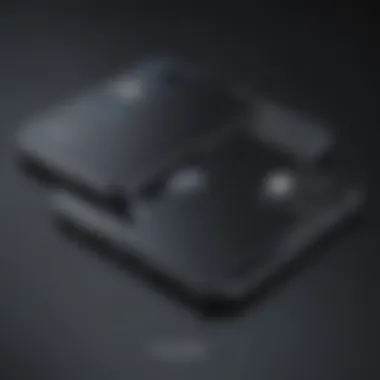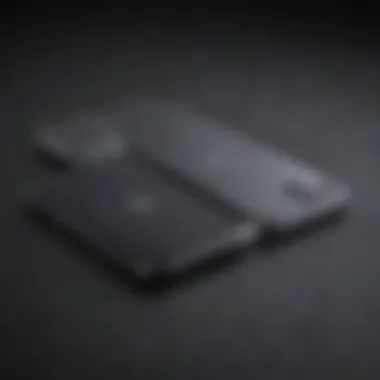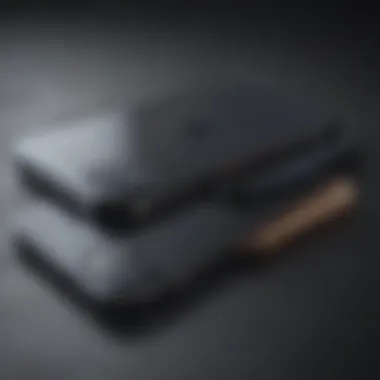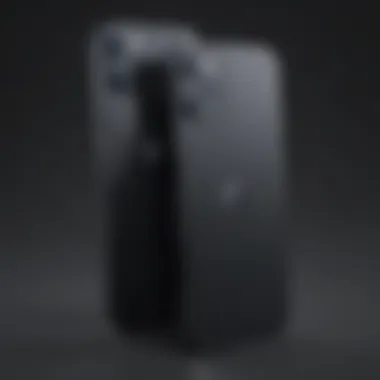Understanding the iPhone 12 Size: Dimensions & Comparisons


Intro
In today’s fast-paced tech world, the size of a smartphone can often define user experience. Particularly, Apple’s iPhone 12 stands out in a sea of devices. With its sleek design and innovative features, it raises questions about how its actual size impacts usability. This piece sets out to explore the dimensions of the iPhone 12, its fit in the broader smartphone landscape, and how it compares against contemporaries and predecessors.
Product Overview
The iPhone 12, launched in late 2020, is more than just a smartphone; it's a blend of elegance and functionality. At its core, it boasts significant upgrades over its predecessors, packing a powerful A14 Bionic chip, which is notably faster than previous models.
Key Features and Specifications:
- Display: 6.1 inches Super Retina XDR
- Resolution: 2532 x 1170 pixels
- Weight: 164 grams
- Camera: Dual 12MP system (wide and ultra-wide)
- Battery Life: Up to 17 hours of talk time
When placed alongside the iPhone 11, it’s evident that Apple is particularly aiming for more than just an aesthetic boost. The iPhone 12 is notably slimmer, though slightly taller and wider, with flat edges reminiscent of older models like the iPhone 4. This design choice not only influences its grip but also plays into the overall perception of modern smartphones.
Performance and User Experience
Performance-wise, the iPhone 12 is a rocket. The A14 chip offers not just speed, but efficiency. Multitasking is a breeze, allowing heavy app usage without a hiccup.
User Interface and Ease of Use:
Navigating through the iOS ecosystem feels seamless. The integration of software and hardware allows for smooth transitions between tasks.
Feedback from users indicates a generally positive experience. Many have praised the responsive display and snappy app launches, though some older iOS users show a bit of nostalgia for previous styles of user interaction.
Design and Build Quality
Delving into the design, the iPhone 12 presents an intriguing mix. Its glass back and Aluminum frame feels premium, with a notable emphasis on durability. The Ceramic Shield front adds a layer of protection, promoting resilience against drops.
Materials Used in Construction:
- Glass front and back
- Aluminum frame
Durability assessments highlight the iPhone 12 as more robust than earlier versions, catering to users who prioritize longevity in phone lifespan.
Software and Updates
With iOS 14, the iPhone 12 brings a plethora of features that enhance the user experience. From home screen widgets to enhanced privacy settings, software on the iPhone is continually evolving.
App Compatibility and Availability:
The vast array of applications, especially in the Apple Store, ensures that users have access to necessary tools. Customization options also allow users to tailor their experience quite extensively.
Price and Value Proposition
At its launch, the iPhone 12 came with a price tag that reflected its high-end positioning, starting at $799. For those seeking a middle-ground device, variations with smaller storage as well as the iPhone 12 mini provide options.
Value for Money Assessment:
Considering the features it offers—especially in terms of performance and usability—the iPhone 12 is often seen as a worthy investment in the premium smartphone category. Compared to similar products, such as the Samsung Galaxy S21, it delivers on performance while retaining a loyal fan base thanks to brand loyalty and ecosystem integration.
"The true measure of a smartphone isn’t just its specs but how those specs translate into daily use."
Throughout this article, we delve into the essence of the iPhone 12, providing not just a numerical understanding of its size but analyzing how that impacts the comprehensive smartphone experience.
Prelims
In the modern world, where smartphone technology advances at a breakneck pace, understanding the physical dimensions of devices like the iPhone 12 is vital. For tech enthusiasts and casual users alike, size matters not just on paper but in hands-on usage. It’s more than just numbers; it speaks volumes about usability, portability, and how well a smartphone integrates into our daily lives.
Purpose of the Article
This article aims to dissect the actual size of the iPhone 12, providing a crystal-clear picture of its dimensions in various contexts. We will dig into specifics like height, width, depth, and weight, ensuring that you understand what these numbers mean in practical terms when you’re holding the phone. The goal is to equip readers with knowledge that goes beyond mere specifications—offering insights that can shape your buying decisions.


Importance of Size in Smartphones
Consider the last time you tried to use a smartphone with one hand. An oversized device can turn neat tasks into clumsy struggles. The dimensions of a smartphone dictate how easily it can be navigated, the comfort during long usage sessions, and even how well it fits into your pocket or bag.
Understanding the size of the iPhone 12 in relation to competitors can help you appreciate its strengths or recognize if it falls short for your needs.
Key factors to consider include:
- Usability: Is it easy to operate with one hand? Can you reach the screen's corners comfortably?
- Portability: Will it fit in your pocket? Is it lightweight enough for casual carry?
- Aesthetics: Does the size affect how visually appealing the device is?
"The size of the smartphone often shapes the very essence of user interaction, making it a key factor in any purchase decision."
This article will delve deeper into these aspects, offering a nuanced view for those keen on making informed choices when it comes to their next gadget.
iPhone Overview
When it comes to smartphones, the iPhone 12 truly stands at the intersection of advanced technology and user-centric design. This section digs into the heart of what sets the iPhone 12 apart, understanding how it combines form and function into what many would consider a near-perfect device. The iPhone 12 is not merely another device in a crowded market; it features a variety of technical specifications that bolster its performance, alongside design elements that make its physical presence feel special and purposeful.
Technical Specifications
The iPhone 12 is powered by the A14 Bionic chip, a game changer in the smartphone world. This processor offers a blend of efficiency and performance that stands tall against competitors. It supports 5G connectivity which is becoming increasingly essential as networks evolve. Here are some key specifications:
- Display: 6.1 inches Super Retina XDR display, providing vivid colors and deep blacks.
- Camera System: Dual 12MP cameras featuring Night mode, which allows for clearer shots in low light.
- Battery Life: Typically lasts about 17 hours of talk time or 11 hours of internet use, depending on actual usage.
- Storage Options: Available in 64GB, 128GB, and 256GB variants, ensuring that users have space tailored to their needs.
Understanding these specifications sheds light on why the iPhone 12 remains a benchmark for performance. Users looking for longevity and functionality will find this particular model hard to pass up.
Design Features
Apple continues to place strong emphasis on the aesthetics and ergonomics of its devices, and the iPhone 12 is no exception. It is crafted from aerospace-grade aluminum and Ceramic Shield front cover, offering impressive durability and a premium feel in hand. Its design does not just stop at looks; it serves practical purposes as well.
- Flat Edges: A departure from the rounded edges of previous models, these provide a firmer grip and modern look.
- Color Options: Available in an array of colors such as Blue, Green, Red, and White, catering to a diverse range of preferences.
- Compact Dimensions: With a height of 146.7 mm, width of 71.5 mm, and a depth of 7.4 mm, the iPhone 12 strikes a balance between being robust yet portable.
Ultimately, the design ensures that while users gain a sophisticated device, they also enjoy convenience and comfort during everyday use. This thoughtful arrangement raises the bar in how smartphones can be designed to fit seamlessly into a user's lifestyle.
In summary, the iPhone 12 embodies a meticulous blend of cutting-edge technology and thoughtful design, making it a model worth exploring if you're looking for practicality alongside aesthetic appeal.
Actual Dimensions of the iPhone
Understanding the actual dimensions of the iPhone 12 is crucial for discerning users who appreciate the subtleties of smartphone design. For many, it's not just about the performance specs hidden under the hood but also how the phone truly fits into daily life. Size influences usability in ways that can often be overshadowed by more glamorous features.
Getting familiar with the measurements can help potential buyers make informed decisions. For instance, navigating one-handed or fitting the device into a pocket or a purse are considerations that come down to the device's dimensions. It’s about making a choice that aligns with individual preferences while ensuring that the smartphone remains functional and comfortable to use.
Height and Width
The iPhone 12 stands at about 146.7 mm tall and possesses a width of roughly 71.5 mm. These dimensions position it comfortably within the mid-size realm compared to many rivals. The proportions are designed purposefully to strike a balance between screen real estate and overall handling.
Picture this: you’re holding the device in one hand while trying to scroll through apps or send a message, and the design does matter. The height ensures that the screen is spacious enough for media consumption while not being so tall that it becomes cumbersome to navigate. Similarly, the width is tailored to fit nicely in hand, making it feel neither overly bulky nor too thin.
Depth and Weight
With a depth of 7.4 mm and a weight of around 164 grams, the iPhone 12 manages to achieve a lightweight form while retaining sturdiness. In a world saturated with phones that feel too hefty or unbalanced, Apple expertly crafts a device that sits lightly in your hand. The slim depth is particularly noteworthy—too thick, and it risks feeling like a brick; too thin, and it may offer a lack of confidence in hand.
Furthermore, the strategic design choices improve the pocketability of the device. You won't need to wrestle with your trousers or bag to slide the iPhone 12 in or out. The lightness does not compromise the premium feel—solid yet airy, a combination often hard to find.
Display Size Specifications
The iPhone 12 showcases a 6.1-inch Super Retina XDR display, making it a bright spot on the smartphone landscape. The resolution, 2532 x 1170 pixels, alongside a pixel density of 460 ppi, brings vibrant colors and sharp images to life.
One of the noteworthy aspects is that the display size and dimensions align well with contemporary user demands. A screen this size is ample for binge-watching your favorite series, yet the phone itself does not become a chore to carry around.


Consumers enjoy a bigger display without needing to resort to a cumbersome, oversized device. Certainly, when examining dimensions, flexibility in user experience is key.
"Contemporary smartphone usage is not merely functional; it's an experience deeply influenced by the dimensions of the device."
In summary, the actual dimensions of the iPhone 12 are crafted with intention and reflect both aesthetic and practical considerations. This careful blend of height, width, depth, weight, and display size converge to form a device that is not just visually appealing but also intuitive to use.
Visual Comparisons with Other Models
When discussing the iPhone 12, it’s crucial to position it within the context of its peers. Visual comparisons with other models allow users not only to appreciate the design aesthetics but also to understand the practical implications of its size relative to other smartphones. This enables potential buyers to make informed decisions based on how these devices might fit into their daily lives.
Understanding differences in size can significantly influence usability. For instance, a larger phone might feel clunky for some tasks, while a smaller one could be more comfortable to hold.
- Visual Differentiation: By comparing the iPhone 12 with models like the iPhone 11 or the iPhone SE, one can see how design elements evolve while maintaining brand identity.
- Functionality: Many users might prioritize certain features over size. A compact design can enhance portability, but it also may lead to compromises in display size or battery capacity.
- User Preferences: As people use their phones for everything from gaming to video calls, the visual comparison of different models offers insights into ergonomics that really matter.
"A visual comparison shifts the focus from mere numbers to the tactile feeling of a device in hand." - Tech Analyst
In the subsections that follow, we'll examine how the iPhone 12 stacks up against previous models and current market competitors. This will offer a clearer picture of where it stands in a bustling smartphone marketplace.
User Experience and Ergonomics
When it comes to smartphones, size plays a pivotal role in shaping user experience and ergonomics. Understanding how a device feels in hand and its overall usability significantly influences consumer preference. An iPhone, particularly, is not just a tool for communication; it’s become an extension of oneself. Thus, the dynamics of gripping, handling, and portability are central to appreciating the iPhone 12's size.
Gripping and Handling
The iPhone 12, with its dimensions of 146.7 x 71.5 x 7.4 mm, strikes a balance between comfort and functionality. Its flat edges, reminiscent of earlier models, provide a sturdier grip, allowing users to hold it with one hand without feeling like it might slip away at any moment.
Many users report that the weight of 164 grams feels just right, neither too heavy to cause fatigue nor light enough to feel flimsy. It's a Goldilocks scenario, where everything feels “just right.”
"The handling of the iPhone 12 feels almost instinctual. You can swipe, tap, and interact without the constant worry of dropping it."
This ease of gripping becomes significant during prolonged use or when multitasking. Users juggling their phone and a cup of coffee can do so with confidence, thanks to the ergonomically designed edges. Additionally, the textured frosted glass back offers a certain tactile pleasure that enhances the overall experience.
Portability and Usage Scenarios
Size inevitably affects portability. The iPhone 12 is compact enough to slide easily into most pockets or small bags. Users often find its dimensions a boon during busy commutes or social outings. Carrying it alongside daily necessities doesn’t require a giant handbag or the constant effort of shoving it into a crowded space.
Consider the varied situations in which one might use their iPhone 12:”
- On-the-go browsing: Standing in line or walking through a crowded area, the size makes it easy to scroll social media updates swiftly.
- Shopping: With the ability to operate with one hand, scanning barcodes or checking prices becomes much more manageable.
- Streaming and Gaming: While at the park or in a café, the screen size is adequate for an enjoyable viewing experience without becoming cumbersome.
In essence, the iPhone 12’s size encourages a lifestyle that is both connected and mobile. Whether you’re taking a quick call or capturing spontaneous moments, the device is designed to amplify these everyday activities.
In summary, the user experience and ergonomics of the iPhone 12 closely intertwine, facilitating ease of use without sacrificing functionality, which is crucial to today's tech-savvy world.
Impact of Size on Performance
When it comes to smartphones, size isn't merely about how the device feels in your hand or whether it fits in your pocket—it's also about how the dimensions affect performance. The iPhone 12 strikes a balance between being compact and powerful, but understanding the actual impact of its size might just give you a clearer view of its capabilities.
From battery life to heat dissipation, the size of a smartphone significantly influences its overall performance. When a manufacturer designs a phone, they are faced with choices that affect not only aesthetics but also utility and effectiveness. Let's take a closer look at two crucial factors that are intertwined with the size of the iPhone 12.
Battery Life Considerations
The size of a smartphone plays a vital role in determining its battery life. Generally, larger devices can accommodate bigger batteries, allowing them to carry more charge and potentially last longer between plug-ins. The iPhone 12 has a battery capacity of 2815 mAh, which is decent, especially considering its dimensions.
However, it's not only the capacity that counts; how effectively that battery operates within the confines of the device's size is equally critical.


- Energy Efficiency: The A14 Bionic chip in the iPhone 12 is designed to optimize battery usage, which means that even with a smaller battery than its predecessor, this model can deliver impressive performance without draining as quickly.
- Physical Layout: An iPhone's layout can affect how quickly the battery discharges. Compact sizes mean less physical space for heat to disperse, which can lead to increased energy use if not managed well.
Despite these factors, users might find that the iPhone 12 lasts comfortably through a busy day. Typically, it offers excellent performance for streaming, gaming, and everyday tasks, even if it doesn't boast the largest battery in the segment.
Heat Dissipation and Performance
Heat management is another area in which size plays a crucial role. When devices push the limits of performance—whether through gaming or multitasking—heat generation becomes an issue. Larger phones typically offer better heat dissipation due to more surface area for airflow and cooling.
For the iPhone 12, its sleek design means that while it can heat up during intensive tasks, Apple has implemented some smart engineering solutions:
- Thermal Management: The device integrates thermal paste and heat spreaders effectively to direct heat away from critical components.
- Optimized Design: The compact design not only looks good but helps in controlling heat by keeping components in close proximity, where proper thermal transfer can occur.
However, there's a trade-off—if the iPhone 12 does get too hot, it can slow down performance to manage temperatures, especially in battery-saving scenarios. Although noticeable under heavy tasks, this adaptive measure is to ensure that the device remains functional rather than overheating.
"While many users prioritize aesthetics and feel, they should also consider how size influences device performance, especially for demanding applications."
Future Implications of Smartphone Sizes
Smartphone size is more than mere numbers on a spec sheet; it reflects a blend of aesthetic appeal, functionality, and user preference. Grasping the future implications of smartphone sizes helps consumers and manufacturers alike to navigate this quickly evolving terrain. As the digital landscape expands, so does the expectation for more immersive and efficient devices. The key considerations include how size affects usability, market trends, and ultimately, the direction the tech industry might take in response to consumer demands.
Trends in Smartphone Design
Over the past few years, it’s become clear that smartphone design is shifting significantly. Devices are getting thinner, lighter, and some are even folding! The trend of maximizing screen space while minimizing the overall device footprint has become a priority. Notably, brands like Samsung and Huawei have embraced this mantra, producing handsets that boast edge-to-edge displays, which not only look impressive but also allow for a more engaging user experience.
While the iPhone 12 has a somewhat classic design, its flat edges and vibrant display are in line with current trends. Users are gravitating toward phones that feel comfortable in one hand, yet offer expansive displays for browsing and media consumption.
Additionally, there is a growing focus on sustainability in design practices. Increasingly, tech companies are exploring ways to incorporate eco-friendly materials in manufacturing, alongside a commitment to reducing waste. Future smartphones might not just fit comfortably in our palms but also align with a more environmentally conscious ethos.
Anticipated Changes in User Preferences
As smartphone functionalities evolve, so do user preferences. Consumers no longer prioritize just the size; they seek a balance between usability, aesthetics, and technological benefits. Recent studies indicate a notable shift towards larger screens for immersive experiences, yet the demand for compact devices still holds strong. In fact, many users appreciate a phone that is easily pocketable without sacrificing screen engagement.
Users are beginning to favor devices that maintain high performance levels without significant battery drain. Heavy, cumbersome phones are falling out of favor, while portrait-friendly sizes with powerful internals are gaining traction.
In addition, features like enhanced cameras, faster processors, and better battery life are often prioritized by users over mere size.
"In the near future, expect the design to reflect an amalgamation of portability and power, daning the line between high-tech gadgets and user-friendly devices."
With these ongoing trends, brands will likely have to adapt quickly. Companies that can deftly combine innovation with the preferences of discerning users will be poised for success. Overall, while the iPhone 12 is already a well-rounded device, the future holds exciting possibilities in smartphone sizing and design that will shape how users connect with their technology.
Summary and Ending
In this final section, we synthesize the insights acquired throughout the article on the actual size of the iPhone 12. Understanding dimensions in smartphones is not just about numbers; it’s about how those numbers translate to real-world experience. The discourse reveals that size significantly dictates user interaction, style, and even preferences among different demographics.
Through our exploration, we emphasized the notable aspects of the iPhone 12’s physical characteristics. The dimensions, while seemingly straightforward, have deeper implications—particularly in ergonomics. For users who prioritize portability, the iPhone 12 stands out due to its lightweight build and manageable size. Conversely, those who lean towards larger displays will find the iPhone 12’s limitations relevant.
Moreover, size influences performance metrics such as heat dissipation, battery life, and even aesthetic appeal. The balance between a device’s form factor and its internal capabilities can make or break the user experience. As devices continue to evolve, these developments in smartphone sizing are particularly pertinent for companies and consumers alike, shedding light on trends that impact choices in the marketplace.
"Smartphone size is not merely a matter of preference; it influences functionality and user satisfaction."
Key Takeaways
- The actual dimensions of the iPhone 12 are key to its usability, impacting how it feels in the hand and fits in pockets.
- Comparisons to older models like iPhone 11 or even competitors highlight how evolving designs cater to specific user needs.
- Understanding the implications of size aids users in making informed decisions tailored to their lifestyle.
- The rising trend towards slimmer, lighter devices shows an industry shift that prioritizes comfort without sacrificing performance.
Final Thoughts on iPhone Dimensions
The iPhone 12 represents a pivotal moment in smartphone design, harmonizing size with functionality. This model serves as a mirror reflecting consumer desires and technological advancements. As we highlighted earlier, the balance of height, width, depth, and weight profoundly influences user behavior.
As technology continues to drive advancements in hardware and software, one can only anticipate how dimensions will adapt to not only suit but enhance the user experience. For Apple, the iPhone 12 is more than just a product; it’s an embodiment of where personal computing meets portability and style in the modern age.
Ultimately, as the smartphone landscape evolves, the size continues to play a crucial role. With changing user needs, the iPhone 12 may well set the stage for future models that prioritize how users interact with their devices over mere technical specifications.



